How many coats do you own? (Not enough?) How many do you need? (More than you know!) Putting need aside, how many should you have? (Plenty!) In your sewing and in planning your wardrobe, do you give as much thought to your coats as you do to your dresses or pants or blouses? My guess is that you do not.
In our very casual world, coats seem to have taken on the essence of “practical” or “function over form.” To me, this is such a shame, as I believe coats have an aura to them unmatched by any other garment. They are, after all, so often a significant part of the first impression you make when arriving at an event or party – or anything for that matter. A fantastic coat can also leave a lasting impression when departing such an event.
In her iconic book, What Should I Wear, Claire McCardell devotes an entire chapter to coats. Here is just a small snippet of her thoughts on the impression that your coat can make: “…Remember that a first impression often comes when you are wearing a coat. When you are interviewed for a job, you keep your coat on. Your future employer’s first impression of you may be based on the coat you are wearing.
When you walk down the aisle of a theatre, you are wearing a coat … your audience has already judged you and the most beautiful dress in the world cannot alter that first impression. Coats ride buses and subways and taxicabs…. A coat is not something to be dismissed lightly.” (The Rookery Press, New York, New York, 2012, pages 61- 62.)
In The Little Pink Book of Elegance: The Modern Girl’s Guide to Living with Style, by Jodi Kahn, she writes: “Many an elegant look is spoiled by throwing on a coat or a wrap that is anything but . . . [I]f you think about the most elegant women you know, or those in the pubic eye, you’ll probably realize they have fabulous outerwear. In the ‘60s, Jacqueline Kennedy asked her designer of the day, Oleg Cassini, to pay special attention to what she wore over her clothes since she was always being photographed coming and going. Even if you don’t have to worry about getting your picture snapped around every corner, a few great coats will transform almost any [look.]” (Peter Pauper Press, Inc., White Plains, New York, c2005, pages 29-30.)
A beautiful coat can also hint at what is beneath it. One of the most elegant looks one can wear (and make for herself) is a matching coat and dress ensemble, where the two pieces are intended only to ever be worn with each other. Such a coat and dress often share similar style lines. This Vogue Couturier Design by Mattli of London is an example of this:
Another example of a coat and dress with complementary style lines is this Vogue pattern:
And although the style lines of the dress and the coat in this Vogue Paris Original by Madame Gres are not matching, clearly the coat and dress featured in blue on the pattern envelope are intended as such an ensemble:
Here is an example of a formal dress and matching coat, sharing seaming details and clearly designed to go together. Would this dress be anywhere as exciting without its matching coat?
Not every coat needs to match a dress, however. Here is a small sampling of coats, both dressy “dressmaker” coats and classy, more tailored coats, the prototypes of which have their rightful place in your coat wardrobe:
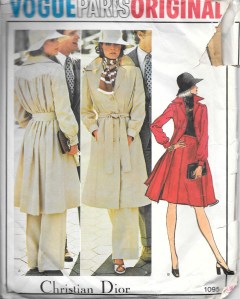
This is my original pattern from which I made the featured coat when I was in my mid-twenties. I loved this coat and only wish I still had it!
One of the many catalogs we receive here at our home is the catalog from the J. Peterman Company. It is so creatively conceived and presented, with each entry reading like a mini story, and often evocative of other times and places. The “Owner’s Manual” (as the company’s catalogs are called) arriving during this past holiday season was no exception. Imagine my delight when turning the page to this entry for a “French Coat with timeless Parisian style.”
But what really caught my eye was the caption at the top of the page: “I want to know the woman in that coat.” In a nutshell, that sums up the power of a beautiful coat. What fun to know that, as ones who can make our coats, we can also be the woman who made that coat!
And now, in deference to some of my readers who want progress reports on my Number Four Classic French Jacket, here are a few photos – and a short quiz for those of you who have never made one of these jackets, but hope to one day.
As you can see, all the machine quilting is complete. I’ve finished the interior seams as much as I can at this point. The next step is to insert the sleeves. Then I can complete the finishing work on the interior seams and the hems and get to work on the trim and the pockets.
QUIZ: How much more will I be using my sewing machine to do this work?
- a) only for the insertion of the sleeves
- b) only to make the pockets
- c) both for the insertion of the sleeves and to make the pockets
- d) not for anything
Back to Coats: Are you ready to make one after reading this post? I hope so!




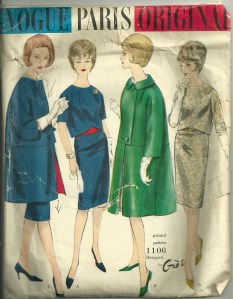
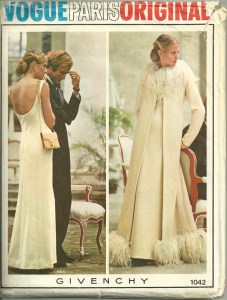

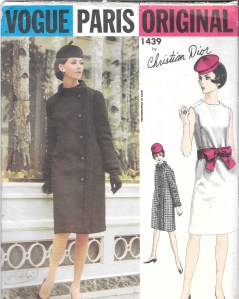

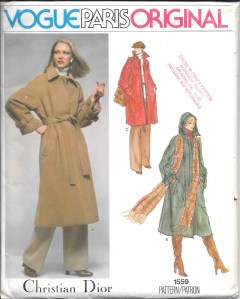
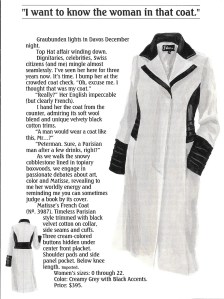
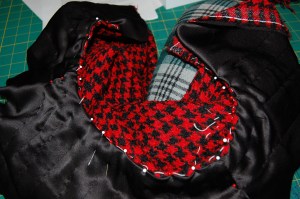



In theory, I would wear and even make more coats. In practice, I wear the same coat much of the time, due to lassitude and poor health. I keep planning to improve it all though! This is a very interesting post on the subject, so I may just…someday.
I think making a coat seems like a daunting project sometimes, which probably keeps some from attempting one. Planning is the first stage in getting it done – so I am cheering for you!
You’re so right about the functionality of our outerwear choices. Here in Toronto I need (for functionality) at least three winter coats for the varying temperatures! I also love the idea of a dress and coat combo. And just as much, I love a dress with a matching jacket. I didn’t realize J. peterman was still around. Thanks so much for mentioning it. I just may try my hand at a coat next season. Thank-you for he inspiration!
I, too, live in a climate which demands coats of varying warmth. Don’t you love it? It’s the perfect excuse to have a large coat wardrobe.
I’m so ready to make another French jacket. And the answer is “you will not use your machine again!” But that’s what I love most — all the hand stitching and finishing. Yours looks fantastic.
I so agree about all that hand stitching. It is so enjoyable (although I will admit I am usually ready for these jackets to be finished by the time I get to the chain!) It’s quite remarkable how little one uses a machine in the making of these jackets, isn’t it?
I agree wholeheartedly. More not less coats! I love the vintage patterns also and am looking to buy a couple online however I am not sure which size to buy? I am usually a size 10 so would I still buy a size 10 in a vintage pattern, in other words are the measurements listed on Vogue patterns of today – bust, hip etc. the same as they were in the past? Thanks for your help – I never miss your posts and love everything you make. Christine.
I used to sell vintage patterns. Always go by the measurements on the pattern envelope, not by “size.” Pattern sizes were not even standardized until 1968. Tip: I learned to love Vogue patterns in the 60’s because I am busty, and, if I used the overbust measurement (as the catalog instructed, instead of the measurement over my bust points,) a Vogue pattern fit my shoulders and back. In other words, I didn’t need a Vogue pattern with a 38 bust, but a 34 bust; it’s much easier to make the waist and hips bigger than it is to make the neck and shoulders smaller. When buying patterns for skirts, I did go by the waist and hip measurements on the pattern envelope, but the body-skimming 1960’s dress styles I preferred just needed a couple of inches added to the hips of the smaller size. If you have broad shoulders, you won’t have the same problem…. Incidentally, if you can find one of the old Butterick or Vogue fitting shell patterns, making it will help you figure out what alterations to expect on all other patterns.
Thank you for this excellent answer to the question from Christine on sizing. I would only add, Christine, that you will probably find you will need to lower the horizontal bust line. The foundation garments worn back in the ’50s, ’60s, and even 70’s had a lot of “lift” to them which can make the apex of the bust higher than we need today. I always need to make a muslin (toile) for fitting whenever I start a new pattern, to help take care of this and other adjustments. Having said that, there is nothing like sewing with these vintage patterns. They are gems of engineering!
Couldn’t agree more. Pre-sewing days, I never had a coat. I distinctly remember the first one I bought – in 2009! – a green twill trench coat, and at the time, it was the most amount of money I’d EVER spent on a garment. I still wear it now, and it still makes me feel really good. Outerwear counts 🙂
There is nothing quite like a wonderful coat! I had saved the Loden coats which my daughter wore when she was a very small child. Now my little granddaughters are wearing them, and even they seem to love wearing beautiful coats. Or maybe it is on a gene??
Another inspiring post. Thanks. I may get to relining a coat I made years ago after all – I still have the pattern!
And relining a coat is such a good thing to do! It can add years to the garment, and if you still have the pattern, you are all set!
I couldn’t agree more as to the importance of great outer ware. I was born the early 60s & I always remember Mum insisting on “good” coats mostly matching my outfits/dresses. Maybe that’s why I continue to have a shameful amount of coats (& jackets) & I love each and every one of them for various reasons.Some are great vintage pieces, many are newer items. I also have a beautiful original 1930s coat pattern but don’t feel brave enough to have a go at making it. Maybe some day….
I, too, was brought up with the recognition of “good” coats versus everyday or play coats. And my sister and I always had Spring coats as well. Your coat wardrobe sounds wonderful (not shameful!), and I bet you feel absolute delight in wearing your many coats!
Nope I would say as sleeves can be handsewn too. As for the coat I can’t more agree with you. I love coats and I love sewing coat. I’m sewing one at the moment it is a Oscar de la Renta Vogue Pattern from 1997 #2019. I have high hopes with this number.
You are correct! Actually the sleeves must be hand sewn in – it would be impossible to do this job by machine. Your Oscar de la Renta coat sounds amazing – what a fabulous project!
My next coat is going to be stadium/barn parka sort of coat…I am going to make it big so I can have lots of layers underneath and still move easily….but probably not this year. I have a thrift store ski jacket that needs a new zipper, why is mending never as much fun as making something new! I could make every one of those coats, they have some great lines and design details!
Enjoy your hand stitching on your jacket. I have this beautiful periwinkle wool, maybe I should think about a quasi French jacket…it is a flannel, so I couldn’t quilt it, but I could do the other stuff, sort of a practice run. I just love yours, they are so Chanel!
I have several patterns for stadium/barn coats, and I fully intend to make one sometime. Even these casual coats can be eye-catching and lovely. And we can add all kinds of inner layers to help make them as warm as we need them to be – not so available in RTW.
Exactly!
Answer to the quiz: D (I think, never having made a LFJ).
And I couldn’t agree more about coats! I have soooo much fabric in my stash specifically purchased to make coats, and I hadn’t sewn any of it to date. Hence the ‘year of the coat’ personal goal for 2018. Let’s see if I get very far!
Yes, I could finish my jacket now with my machine taking a vacation! I will probably add the lining to the pockets by machine for this jacket. It can be done by hand (which i have done in the past), but this boucle is very stable and I think sewing in the lining by machine might be the way to go this time. I’ll let you know what I do!
“Year of the Coat” – I like that! Go for it!
One of my most memorable outfits, made by my mother, was a fully-lined, floor-length coat and dress in white brocade. Made for me to attend a prom in 1968. Definitely the best dressed on that occasion.
Sounds glorious! No wonder you remember it so well. Thank you for sharing this little story!
Coats are so important! I feel the cold so I need lots of different ones. I have about 6 which are not enough (even though my husband thinks I have plenty). I have just recently taken up sewing after a decade hiatus, hopefully I will get my skills back quickly and I can sew a coat for next winter.
I don’t think one can ever have too many coats. Happy Sewing to you – and here’s to a new coat in your sewing future!
Great post. I’m planning on a longer version of the French jacket which will double as a coat. Can’t wait to see your red/black jacket complete.
This post is such a pleasure to read and to peruse again later like a magazine. I wish I could’ve sent you some of our sunshine while you worked on the black charmeuse lining. That outfit will be gorgeous forever but I do hope you get to wear it this year. I think you will because winter seems to be holding on with both hands. We have springlike days and the last of the geese have headed out, but the daffodils and camellias continue to show off a late blossom (usually ended by Valentines Day).
Well, I am still plugging away on the French jacket – and I’m inspired to finish it with the thoughts of wearing it before winter has departed. March can be a bear here in the Northeast, so I suspect I’ll get my wish! With any luck(?) I hope to be able to do a post on it, maybe this week… Enjoy those daffodils and camellias!
You make a good point. Unfortunately, I live in Louisiana. I rarely need a boat.